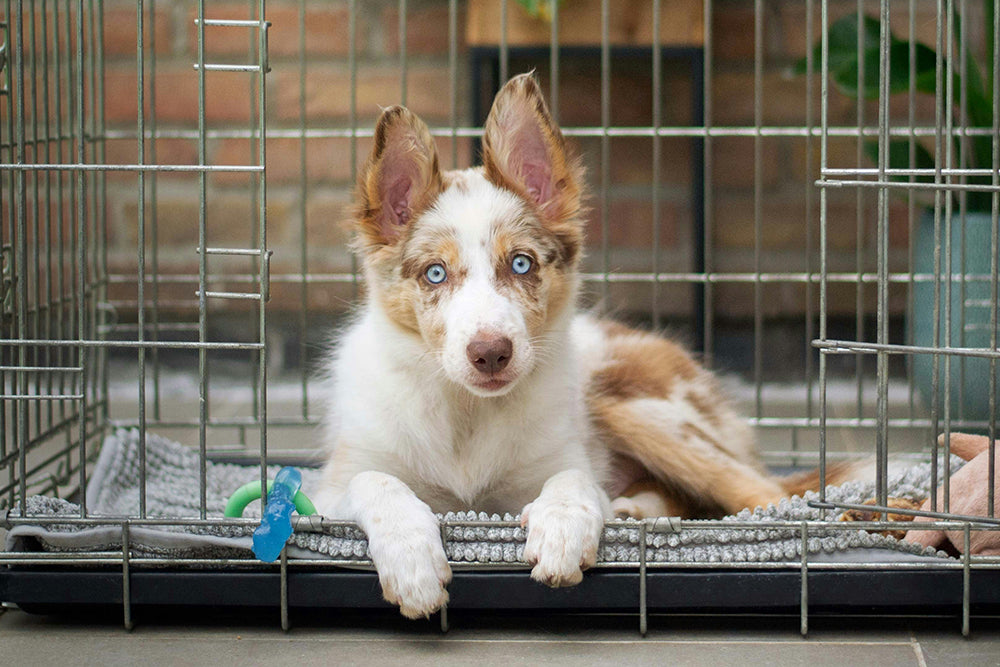Crate training is an essential part of raising a well-adjusted and happy puppy. It not only provides a safe and secure space for your pup but also helps with house training and reduces unwanted behaviors. Here’s a step-by-step guide to successfully crate training your puppy.
Why Crate Training?
- Safety and Comfort:
- A crate gives your puppy a safe, cozy space of their own where they can relax and feel secure. It mimics a den-like environment that satisfies their natural instincts.
- House Training:
- Crate training is one of the most effective methods for housebreaking a puppy. Puppies naturally avoid soiling their sleeping area, which helps them learn bladder and bowel control.
- Prevents Destructive Behavior:
- When you can’t supervise your puppy, a crate can prevent them from chewing on furniture, shoes, or other household items.
- Travel and Vet Visits:
- A crate-trained puppy is more comfortable during travel and vet visits, making these experiences less stressful for both of you.
Step-by-Step Guide to Crate Training
- Choosing the Right Crate:
- Select a crate that is just big enough for your puppy to stand up, turn around, and lie down comfortably. A crate that's too large may encourage them to use one end as a bathroom.
- Introduce the Crate Positively:
- Place the crate in a busy area of your home where your puppy can see and hear you. Make it inviting with soft bedding and some of their favorite toys.
- Allow your puppy to explore the crate at their own pace. Never force them inside.
- Create Positive Associations:
- Use treats and praise to encourage your puppy to enter the crate. Feed them their meals near the crate and gradually move the food bowl inside.
- Give them a special treat or toy that they only get when they are in the crate.
- Gradual Acclimation:
- Once your puppy is comfortable going in and out, close the door for a few minutes while you are nearby. Gradually increase the time they spend in the crate with the door closed.
- Stay close by at first and then leave the room for short periods to help them get used to being alone.
- Establish a Routine:
- Use the crate at consistent times, such as bedtime or when you leave the house. This helps your puppy understand that the crate is a regular part of their routine.
- Avoid using the crate as a punishment. It should always be a positive, safe space.
- Handling Whining and Barking:
- If your puppy whines or barks in the crate, wait for a brief pause in the noise before letting them out. This prevents them from associating their noise-making with being let out.
Tips for Success
- Keep Sessions Short and Positive: Crate time should be enjoyable. Keep initial sessions short and gradually build up the time.
- Use the Crate for Naps: Encourage your puppy to nap in the crate during the day to reinforce positive associations.
- Avoid Long Periods: Puppies should not be crated for more than a few hours at a time. They need frequent potty breaks and interaction.
Common Mistakes to Avoid
- Using the Crate as a Punishment:
- Never use the crate as a form of punishment. It should always be associated with positive experiences.
- Too Much Time in the Crate:
- Puppies need plenty of exercise, social interaction, and potty breaks. Too much time in the crate can lead to anxiety and behavioral issues.
- Inconsistent Crate Use:
- Consistency is key. Use the crate regularly as part of your puppy’s daily routine to help them feel secure.
Crate training can take time and patience, but with the right approach, it can become one of the most valuable tools in your puppy-raising toolkit. By creating a positive and consistent experience, your puppy will soon see the crate as their special place to relax and unwind.


